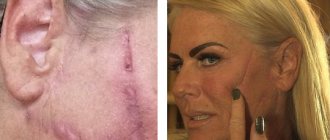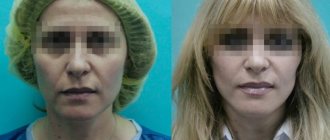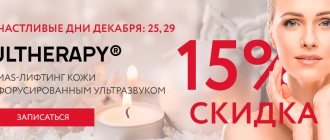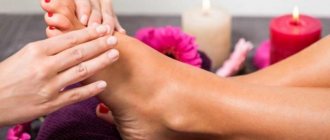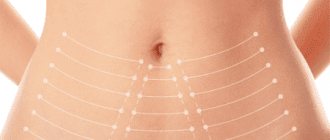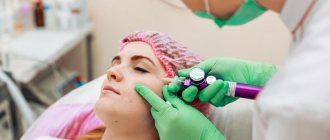from 22,000 rub.
- Maximum natural result
- Individual selection depending on the problem
Make an appointment Find out the cost
Thread lifting, or otherwise thread lifting, is a procedure aimed at rejuvenation, eliminating asymmetry and combating the pronounced signs of aging of the skin of the face, neck, décolleté and body.
For intensive facial rejuvenation both before and after forty years, the well-known method of thread reinforcement of the skin or Aptos thread is used in Krasnodar. A lift using a long-established method is considered a transitional procedure, when non-surgical means no longer provide the maximum desired result, and it is too early to turn to surgical intervention.
Aptos threads are either absorbable or non-absorbable; the use of a specific type depends on the area of the lifts (forehead, neck or chin), the condition of the epidermis and the number of wrinkles. The threads are embedded under the skin to form a kind of frame that will keep the tissue from sagging. The technique was developed not only for the face, it is effectively used for lifting the abdomen, hips, neck, arms, chest and décolleté.
Prices for a circular facelift Procedure for installing APTOS threads Indications and contraindications for thread lifting Advantages and results of a circular facelift Questions and answers on APTOS thread lifting
Indications for use
- “Floating” facial contour - sagging skin, so-called ptosis
- Wrinkles of varying severity
- Prevention of aging
- Drooping eyebrow arches, wrinkling of the skin of the temporal zone
- Sagging cheeks, jowls
- Cicatricial changes in skin texture, scars
- Flabbiness of the skin in the submandibular area
- Mimic skin creases - “nasolabial folds”, “puppet” wrinkles
- Drooping corners of lips
The technique is most effective for preventive purposes in combating age-related skin changes. With significant sagging skin and a massive layer of soft tissue, a scalpel, alas, cannot be avoided.
Contraindications to thread lifting
Not recommended during:
- infectious and viral diseases;
- pregnancy;
- breastfeeding;
- for inflammation
- for bleeding disorders;
The technique is contraindicated in patients with cancer, diabetes mellitus, or allergic reactions to suture material or anesthetics.
Possible complications: in places where the skin is punctured, there may be bruises, bruises, swelling, pain, decreased blood circulation, and as a result, some whitening of the skin area, the appearance of nodules on the skin at the location of the edge of the thread, over-tightness due to incorrect calculation of the length of the thread, asymmetry with uneven administration, allergic reactions.
Contraindications to the use of APTOS threads
Absolute 1.4 degree gravitational ptosis of the soft tissues of the face (presence of pronounced excess facial skin). 2. Severe skin atony. 3. Acute inflammatory diseases in the intervention area. 4. ARVI. 5. Exacerbation of chronic diseases. 6. Hemophilia, blood clotting disorders. 7. Polyvalent allergy. 8. Oncological diseases in the acute phase, period of chemotherapy, radiation therapy. 9. Acute inflammatory diseases of the oral cavity. 10. Acute inflammatory diseases of the ENT organs. 11. Decompensated systemic and autoimmune diseases (Sjögren’s disease, scleroderma, Tsumbusch lichen sclerosus, SLE, etc.). 12. HIV infection, Viral hepatitis. 13. Decompensated diabetes mellitus. 14. Menstruation 1 week cycle. 15. Pregnancy, lactation. 16. Previously introduced non-biodegradable non-shell implants in the intervention area (PAAG, silicone, petroleum jelly, biopolymer). Relative 1. Arterial hypertension above grade 2. 2. IHD above 2FC. 3. Taking anticoagulants, antiplatelet agents.* 4. Xerosis, “cigarette paper” symptom.** 5. Moderate skin atony.** 6. Darmatoporosis.** 7. Hyperkinesis.** 8. 3rd degree of gravitational ptosis of the soft tissues of the face. ** 9. History of keloid formation. * Consult your physician about the possibility of temporarily discontinuing or replacing medications. ** Consult your doctor to develop a tissue preparation program for thread lifting.
Duration of retention of mesothread results
The results of thread reinforcement have both a pronounced immediate effect and a long-lasting effect, which appears with the formation of fibrous capsules around the implanted threads. Depending on the material and thickness, threads have different periods of biodegradation in tissues. On average, this period is about a year to a year and a half. When using non-degradable threads, the period of preservation of the result is longer - up to 3-5 years, but subsequently, such threads can break and are a contraindication for a number of other effective cosmetic operations.
Unfortunately, due to the constant action of gravity, the effect of a thread lift fades over time. Nevertheless, this procedure allows you to prevent early aging of the skin and eliminate the “tired look” of the face. With regular use, it is possible to delay the need for surgical plastic surgery for a long time.
Carrying out the procedure
Preparation Collecting anamnesis, clarifying possible contraindications, the presence of allergic reactions. If necessary, the doctor is certified by the results of medical tests
. Determination of the correction zone, age and physiological indications. Consultation on the choice of threads and techniques for their placement. Information about the rules of preparation for the day of the procedure.
Avoid alcohol intake for two weeks. It is not recommended to prescribe the procedure in the first week of the menstrual cycle, as increased sensitivity to pain is likely. Avoid taking anticoagulants.
Carrying out the procedure:
- Skin cleansing and local anesthesia with anesthetic cream.
- Marking - using a medical marker, the doctor determines the points of fixation of the threads, which will preserve the natural movement of the facial muscles.
- Installation of threads. The threads are inserted using a double-edged needle, which allows movements in different directions and thereby minimizes skin trauma. The doctor uses various thread lifting techniques and materials depending on the selected area. For example, to create a lifting effect in an area of increased facial expression, and, consequently, tension, spiral-shaped threads are used. The thread lifting procedure, taking into account pain relief and preparation, takes no more than an hour. For hygienic purposes, the puncture sites are sealed with small flesh-colored patches for a couple of days until healing. Treatment does not require a long stay in the clinic as during surgical operations. After the session, the patient remains under the supervision of a doctor for about half an hour; a cold gel compress is applied to prevent the appearance of hematomas. The first results are noticeable immediately after the procedure. But the invasiveness of the technology inevitably entails the need for recovery time.
Rehabilitation.
Recovery after thread lifting can last from 7 to 22 days; pain is possible at the puncture sites. The doctor will make a list of activities that will help make this period more comfortable, for example:
- applying ice to the injection sites 4 times a day for 10-15 minutes
- taking an analgesic
- daily care in the treatment area using antiseptic solutions and decongestant ointments (“Traumel”, “Heparin”)
During the first days, the same precautions are recommended as for any invasive cosmetic procedures; hot food and drinks, alcohol, and smoking are excluded. Contraindicated: sunbathing, sauna, swimming pool, heavy physical activity, massage in the treatment area. It is advisable to plan travel by plane so that the departure is no earlier than a week after the procedure. It is important to remember that active facial expressions in the first week may have an undesirable effect on the fixation of the threads.
Recommendations for a speedy recovery
1. Within 48 hours after the procedure, apply cold to the correction area 3-4 times a day for 15 minutes. 2. If pain persists, it is possible to use analgesics in accordance with the instructions (Nimesil, Ketonal, etc.). 3. To speed up the rehabilitation process, drugs and procedures that reduce swelling are recommended (Traumel, Heparin, microcurrent therapy, etc.). 4. Do not take hot drinks or hot food for 2-3 days. 5. For 3 days, treat skin puncture sites with antiseptic solutions. 6. Within 3-5 days after the procedure, you may be prescribed antibacterial therapy: (for example, “Cifran” 0.5 g, 1 tablet 2 times a day). 7. For 14 days, limit the activity of facial expressions and refrain from fitness activities. 8. You should give up alcohol (for 2-3 weeks), massage and physiotherapy (for 2 months), thermal procedures (including visiting the bathhouse, sauna and pool) at the implantation sites (for 1 month), myostimulation procedures ( for 2 months). 9. It is recommended to refrain from flying for 1 week. 10. To avoid losing the results of a thread lift, it is recommended to sleep only on your back for at least 2 weeks.
ATTENTION! It is mandatory to visit a doctor on the 7th and 14th day after the thread lifting procedure
How painful will the APTOS thread placement procedure be?
Thread lifting according to Aptos methods is performed using local infiltration anesthesia, for which an anesthetic solution (Ultracain DS Forte, Ubistezin, etc.) is injected into the puncture area and along the contour of the threads. However, some patients experience discomfort. The same reaction is possible at the beginning of the procedure, when a puncture is made through which the threads will be implanted.
Does the procedure require preliminary preparation?
Preliminary preparation is usually not required. However, about a week before the correction, it is advisable to stop taking antiplatelet agents (acetylsalicylic acid, aspirin, dipyridamole, pentoxifylline, xanthinol nicotinate, etc.) and dietary supplements (dietary supplements) that affect blood clotting. If the drug was prescribed to you for medical reasons, consult with your doctor to determine the possibility of temporarily discontinuing therapy.
What complications can occur after the procedure?
Complications after thread correction are quite rare and can be corrected by consulting a doctor. After the procedure, swelling, unevenness, bruising, slight retractions and asymmetry may occur. Such manifestations do not require correction and disappear within a few weeks, in rare cases they can last up to two months. Severe hematomas, contouring of threads, and strong retractions of the skin at puncture sites are considered an emergency situation.
What are Aptos threads made of? Is this material safe?
Depending on the area of correction, age and individual wishes of the patient, non-absorbable or absorbable threads are used. The first ones are made of polypropylene, a synthetic suture material that has been used in surgery for more than 50 years. It is safe, does not cause allergies and is not rejected by the body. Absorbable sutures are biocompatible with human tissue and are made from a copolymer of L-lactide and -caprolactone. The L-lactic acid included in the composition has an additional rejuvenating effect, activating the natural processes of skin cell renewal. L-lactic acid is released until the threads are completely dissolved, so the results of the procedure only improve over time.
How long does the rehabilitation period last?
The rehabilitation period lasts about 1–2 weeks. To shorten the rehabilitation period, the following may be prescribed: 1. Lymphomyosot – 15 drops 1-2 times a day (possible contraindications, consult your doctor); 2. Plasmolifting – before, during and after the procedure, then every 7–10 days (3–4 procedures in total); 3. Microcurrent therapy, and other restorative procedures - the next day after the procedure, and throughout the entire recovery period; 4. Hardware cosmetology – after 2–3 weeks; 5. Mesotherapy, biorevitalization, botulinum therapy - after 2–3 weeks. During the rehabilitation period, asymmetry, swelling, irregularities, bruises, and retractions may be observed. Such manifestations are normal during the rehabilitation period and can last from a week to two months.
How soon can you see the effect and how long does it last?
The result is noticeable immediately after the procedure and becomes more pronounced by the end of the second week. The duration of the effect depends on the correction area, the type of threads inserted, the individual characteristics of the patient, his lifestyle and compliance with recommendations during the rehabilitation period. When using absorbable threads, it lasts up to 2-3 years, non-absorbable threads - up to 5 years. The procedure can be repeated no earlier than after 2 months. The number of procedures is determined by the attending physician individually.
If you have any additional questions, you can contact me personally.
Sign up for a consultation
Combination with other procedures
Fillers + threads - this combination is recommended to achieve a volume effect due to the filling effect of fillers and correction of sagging tissue with threads. This treatment is recommended for deep and medium wrinkles, when modeling the oval contour of the face.
Thread lifting + RF - to consolidate the lifting effect, after 2-4 weeks it is possible to further improve the properties of the skin, increase its elasticity using radio wave lifting.
Botox or Dysport + Threadlifting - these injection procedures can be performed either in one procedure or separately. The best combination is Botox first, followed by threads a few days later. With this procedure, creases and places that require correction are clearly visible. Botox relaxes facial muscles, and the threads create a supporting frame for the skin. Laser peeling/microdermabrasion + threads - preliminary facial peeling stimulates the processes of neocollagenesis, which, in combination with mesothreads, enhances the effect of increasing skin elasticity and forming a tightened facial contour. It is recommended to carry out all exfoliating procedures at least 12-14 days in advance. or after the same amount of time after the thread reinforcement procedure.
Plasmolifting + threads - mesothreads only create a frame; the long-term effect depends on the ability of the skin to create a new tissue membrane around them. Platelet blood plasma creates a favorable environment due to growth factors, signaling proteins that trigger the natural processes of collagen, elastin formation and hyaluronic acid production.
Microcurrent therapy + thread reinforcement. Electrical micropulses trigger natural rejuvenation processes by normalizing metabolic processes. The color, quality and turgor of the skin improves. Of course, with such procedures there is no such powerful effect as growth factors, but the procedure is absolutely painless and non-invasive.
Threads + Biorevitalization - “hyaluronic acid” 2 weeks before the installation of threads ideally prepares the skin for lifting. During this period, the skin will be saturated with moisture, the relief will straighten out, and its color and quality will improve. In this case, it is easier to achieve a pronounced rejuvenation result, and fewer mesothreads may be needed.
Procedure for installing APTOS threads
The procedure takes place in several stages, under local anesthesia. Each thread is inserted separately using a special cannula, and the procedure itself takes from 20 to 50 minutes, depending on the number of threads inserted. So, the stages of the procedure:
- Consultation. If the doctor suspects the presence of contraindications, laboratory diagnostics will be prescribed. If a patient comes with a request to “make threads”, but he has no indications for this technique, the doctor will offer alternative methods of facial rejuvenation.
- Cleansing and disinfecting the skin. The face is cleaned of makeup and impurities, then an antiseptic facial treatment is carried out and the doctor makes markings. Marks and guide lines are made at the places where the threads are supposed to be inserted.
- Local anesthesia. It is required to eliminate pain during the procedure.
- Preparation of threads for installation in tissue (The package with threads is opened in front of the patient).
- Inserting threads under the skin using cannulas. An APTOS thread is inserted into the empty cannula. The cannula is passed through the lift line and pulled out, leaving the thread in the tissue. The thread is pulled slightly at both ends to the required level of tightening. The ends of the threads are cut off, and the thread itself remains motionless under the skin.
- Treatment of puncture sites and the face as a whole. Applying a restorative and soothing agent and receiving recommendations from a doctor.
Immediately after injection, swelling, bruising and unevenness may appear, which disappear after 3-5 days. It is not recommended to massage the area where the threads were inserted, sleep on your side or stomach (preferably on your back), or visit a solarium, bathhouse or sauna for 5-7 days. You should also refrain from active facial expressions and sports (fitness) for a month.
Indications and contraindications for thread lifting
- drooping of the middle third of the face;
- unclear contour of the oval face;
- shaved;
- double chin;
- loose skin on the neck;
- marionette lines, nasolabial folds;
- drooping of the corners of the lips, eyes, eyebrows;
- severe thinness of the face;
- fold between the eyebrows;
- expression wrinkles;
- dehydrated skin;
- Folds and sagging skin in various places of the body.
- pregnancy, lactation;
- intolerance to infiltration anesthesia;
- mental disorders;
- skin diseases;
- Formation of keloid scars on the body;
- viruses, infections;
- herpes;
- diabetes;
- oncology;
- chronic diseases of internal organs;
- endocrine pathologies;
- the presence of implants in the area of proposed correction.
Make an appointment
Benefits and results of a circular facelift
The main advantages of thread lifting:
- compatibility with other hardware, laser, injection procedures (consultation with a cosmetologist is required);
- visible anti-aging effect that increases over time;
- no need for anesthesia;
- no scars;
- 100% biocompatible;
- preservation of natural facial contours;
- fast rehabilitation;
- long-term result.
A distinctive feature of this technique is a one-time visit to the doctor (during administration) and a control visit 2 weeks after the session. The tightening effect becomes noticeable immediately after cosmetic manipulation, and only intensifies over time. The final result becomes visible after a few months.
